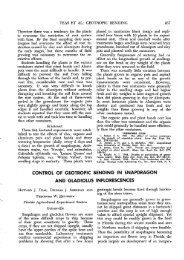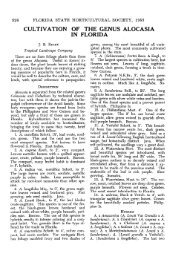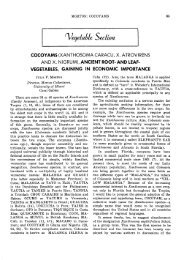Cold-Hardening Young 'Valencia' Orange Trees on Swingle
Cold-Hardening Young 'Valencia' Orange Trees on Swingle
Cold-Hardening Young 'Valencia' Orange Trees on Swingle
You also want an ePaper? Increase the reach of your titles
YUMPU automatically turns print PDFs into web optimized ePapers that Google loves.
Proc. Fla. State Hort. Soc. 89:9-10. 1976<br />
COLD-HARDENING YOUNG VALENCIA1 ORANGE TREES<br />
ON 'SWINGLE' CITRUMELO (CPB-4475)<br />
AND OTHER ROOTSTOCKS<br />
G. Yelenosky<br />
Agricultural Research Service,<br />
U.S. Department of Agriculture,<br />
Orlando, FL 32803<br />
Additi<strong>on</strong>al index words. Freeze injury, citrus.<br />
Abstract. <str<strong>on</strong>g>Young</str<strong>on</strong>g> 'Valencia7 orange trees (Citrus sinensis<br />
(L) Osbeck) <strong>on</strong> '<strong>Swingle</strong>' citrumelo (C. paradisi Macf. X<br />
P<strong>on</strong>cirus trifoliata (L) Raf.) were cold-hardened and freezetested<br />
in c<strong>on</strong>trolled-envir<strong>on</strong>ment rooms. 'Valencia7 <strong>on</strong><br />
'<strong>Swingle</strong>' rootstock cold-hardened more than <strong>on</strong> rough lem<strong>on</strong><br />
(C. lim<strong>on</strong> (L) Burm. f.), and compared favorably with 'Valen<br />
cia' <strong>on</strong> sour orange (C. aurantium L.) rootstock. <str<strong>on</strong>g>Cold</str<strong>on</strong>g>-hardened<br />
leaves were not injured at —3.89 C (25 F) for 3 hr, and stems<br />
withstood -6.11 C (21 F) for 3 hr. Other rootstocks included<br />
'Large Flower' trifoliate orange (P<strong>on</strong>cirus trifoliata (L.) Raf.),<br />
and 'Carrizo' and 'Rusk' citranges (C. sinensis X P. trifoliata).<br />
Agricultural Research Service, U.S. Department of Agri<br />
culture, released '<strong>Swingle</strong>' citrumelo rootstock to citrus<br />
growers in 1974. '<strong>Swingle</strong>,' formerly citrumelo CPB-4475,<br />
has many favorable traits. '<strong>Swingle</strong>' is associated with high<br />
citrus yields (5), tolerates viruses, resists root-rot organisms,<br />
withstands high salt c<strong>on</strong>tent in soils, and seemingly lias cold<br />
tolerance (4). C<strong>on</strong>tinued evaluati<strong>on</strong>s are warranted as<br />
'<strong>Swingle</strong>' is phased into commercial plantings.<br />
This study rates the cold-hardiness of young 'Valencia*<br />
trees <strong>on</strong> '<strong>Swingle</strong>' rootstock relative to other rootstocks.<br />
Tissue tolerance of ice formati<strong>on</strong> at different temperatures<br />
for different durati<strong>on</strong>s is included for <str<strong>on</strong>g>'Valencia'</str<strong>on</strong>g> orange trees<br />
<strong>on</strong> '<strong>Swingle</strong>' rootstock.<br />
Materials and Methods<br />
Test trees were <str<strong>on</strong>g>'Valencia'</str<strong>on</strong>g> <strong>on</strong> '<strong>Swingle</strong>/ sour orange,<br />
rough lem<strong>on</strong>, 'Large Flower' trifoliate orange, and 'Carrizo'<br />
and 'Rusk' citranges. Rootstock seed were germinated and<br />
seedlings were grown in a glasshouse under normal daylight.<br />
<str<strong>on</strong>g>'Valencia'</str<strong>on</strong>g> budwood was from a mature tree <strong>on</strong> the A. H.<br />
Whitmore Foundati<strong>on</strong> Farm near Leesburg, Florida.<br />
Budded trees were maintained with routine glasshouse<br />
procedures.<br />
C<strong>on</strong>trolled-envir<strong>on</strong>ment tests included 9- to 18-m<strong>on</strong>th-old<br />
uniform trees in groups of 10 to 30 single-tree replicates.<br />
Potted trees were in 3-liter cans filled with a prepared soil<br />
mix c<strong>on</strong>taining 1 part sand, 2 parts vermiculite, 7 parts<br />
peat, and a trace of mixed fertilizers. One-half of the group<br />
of test trees remained in the glasshouse as n<strong>on</strong>hardened<br />
c<strong>on</strong>trols, and the others were cold-hardened in c<strong>on</strong>trolledenvir<strong>on</strong>ment<br />
rooms. Both halves were freeze-tested simul<br />
taneously.<br />
<str<strong>on</strong>g>Cold</str<strong>on</strong>g>-hardening was moderate in c<strong>on</strong>trolled-envir<strong>on</strong>ment<br />
rooms as reported previously (7). Temperature-light periods,<br />
except where noted, were 21.1 C (70 F), 12-hr light and 10 C<br />
(50 F) dark for 14 days, followed by 14 days of 15.6 C (60 F)<br />
light and 4.4 C (40 F) dark. During cold-hardening treat<br />
ments, glasshouse temperatures ranged from 32.8 C (91 F)<br />
days to 23.3 C (74 F) nights. These temperatures do not<br />
cold-harden citrus. Al<strong>on</strong>g with previously reported coldhardening<br />
procedures, similar freeze patterns were followed<br />
with a low of -6.7 C (20 F) for 4 hr (7). In trials to de<br />
termine tissue tolerance of external ice at different tempera-<br />
Proc. Fla. State Hort. Soc. 89: 1976.<br />
tures, trees were misted with precooled 1 C (33.8 F) distilled<br />
water from a hand sprayer. Water froze <strong>on</strong> trees within 5<br />
min after misting at different test temperatures. This in<br />
duced H2O soaking and apparent freezing inside the leaves<br />
and stems.<br />
Plants were returned to a glasshouse after thawing at<br />
about 24 C (75 F). Four weeks later, foliage kill and stem<br />
dieback were rated.<br />
Results and Discussi<strong>on</strong><br />
<str<strong>on</strong>g>'Valencia'</str<strong>on</strong>g> trees cold-hardened to different degrees. Freezeinjury<br />
ratings separated trees <strong>on</strong> different rootstocks based<br />
<strong>on</strong> stem dieback, but not <strong>on</strong> foliage kill. Rootstock relati<strong>on</strong><br />
ships were found in tests with both 9- and 18-m<strong>on</strong>th-old<br />
trees. This is an improvement over field experience with<br />
young citrus trees. Natural freezes often injure trees less<br />
than 5 years old so uniformly that rootstock relati<strong>on</strong>ships<br />
are lost. This is largely the result of inadequate coldhardening<br />
prior to advective and radiati<strong>on</strong>-type freezes.<br />
Radiati<strong>on</strong>-type freezes can be expected annually in Florida<br />
and are characterized by rapid heat loss shortly after 4 p.m.<br />
(6).<br />
In this study, injury to 9-m<strong>on</strong>th-old <str<strong>on</strong>g>'Valencia'</str<strong>on</strong>g> trees was<br />
lowest <strong>on</strong> '<strong>Swingle</strong>,' followed by 'Rusk' citrange, then sour<br />
orange, and was highest <strong>on</strong> rough lem<strong>on</strong> (Table 1). No<br />
leaves survived —6.7 C (20 F) for 4 hr, regardless of rootstock.<br />
However, <str<strong>on</strong>g>'Valencia'</str<strong>on</strong>g> stem survival differed am<strong>on</strong>g<br />
rootstocks. <str<strong>on</strong>g>Trees</str<strong>on</strong>g> <strong>on</strong> '<strong>Swingle</strong>' averaged 9% stem dieback.<br />
Injury was three times greater <strong>on</strong> 'Rusk' citrange, more than<br />
five times greater <strong>on</strong> sour orange, and more than nine times<br />
greater <strong>on</strong> rough lem<strong>on</strong>.<br />
Table 1. Mean freeze2 injury to 9-m<strong>on</strong>th-old Valencia orange trees <strong>on</strong><br />
different rootstocks.<br />
Rootstock<br />
<strong>Swingle</strong><br />
Rusk citrange<br />
Sour orange<br />
Rough lem<strong>on</strong><br />
C<br />
100<br />
100<br />
100<br />
100<br />
Foliage killy<br />
NC<br />
100<br />
100<br />
100<br />
100<br />
Stem dieback<br />
C<br />
NC<br />
9ax<br />
27 ab<br />
48 be<br />
86 d<br />
100<br />
100<br />
100<br />
100<br />
8-6.7 C (20 F) for 4 hr.<br />
yC = cold-hardened for 14 days at 21.1 C (70 F), 12 hr light and 10 C<br />
(50 F) dark followed by 14 days of 15.6 C (60 F) light and 4.4 C (40 F)<br />
dark. NC = not cold-hardened (glasshouse).<br />
xOdds are 19:1 that means are different if followed by different letters.<br />
In trials with 18-m<strong>on</strong>th-old, cold-hardened <str<strong>on</strong>g>'Valencia'</str<strong>on</strong>g><br />
trees <strong>on</strong> '<strong>Swingle</strong>/ foliage kill was severe, but less than<br />
100%. Average leaf survival was best <strong>on</strong> trees <strong>on</strong> '<strong>Swingle</strong>',<br />
but this difference was not statistically significant (Table 2).<br />
Differences in <str<strong>on</strong>g>'Valencia'</str<strong>on</strong>g> stem dieback were statistically dif<br />
ferent between trees <strong>on</strong> '<strong>Swingle</strong>' and <strong>on</strong> rough lem<strong>on</strong>. Stem<br />
dieback was almost 4-10 times greater for trees <strong>on</strong> rough<br />
lem<strong>on</strong> than for trees <strong>on</strong> the other rootstocks.<br />
Differences between trials with 9- and 18-m<strong>on</strong>th-old<br />
trees are attributed largely to differences in age and/or<br />
tissue maturity. In general, the principle of "the older the<br />
tree, the more tolerance of freezes" is expressed as less injury<br />
to 18- than 9-m<strong>on</strong>th-old trees in this study. However, I<br />
cannot account for greater differences am<strong>on</strong>g rootstock with
Table 2. Mean freeze* injury to 18-m<strong>on</strong>th-old Valencia orange trees <strong>on</strong><br />
different rootstocks.<br />
Rootstock<br />
<strong>Swingle</strong><br />
Rusk citrange<br />
Carrizo citrange<br />
Sour orange<br />
Trifoliate orange<br />
Rough lem<strong>on</strong><br />
Foliage kill*<br />
C<br />
72 ax<br />
86 a<br />
82 a<br />
90 a<br />
95 a<br />
92 a<br />
NC<br />
100<br />
100<br />
100<br />
100<br />
100<br />
100<br />
f<br />
% 0<br />
Stem dieback<br />
c<br />
6a<br />
7a<br />
10 a<br />
3a<br />
6a<br />
39 b<br />
NC<br />
100<br />
100<br />
100<br />
100<br />
100<br />
100<br />
z-6.7 C (20 F) for 4 hr.<br />
yC = cold-hardened for 14 days at 21.1 C (70 F), 12-hr light and 10 C<br />
(50 F) dark followed by 14 days of 15.6 C (60 F) light and 4.4 C (40 F)<br />
dark. NC = not cold-hardened (glasshouse).<br />
xOdds are 19:1 that means are different if followed by different letters.<br />
9- than with 18-m<strong>on</strong>th-old trees. In the field, rootstock effects<br />
tend to increase as trees age. <str<strong>on</strong>g>Young</str<strong>on</strong>g> trees are known to be<br />
more cold susceptible than older trees because of size dif<br />
ferences. Size differences am<strong>on</strong>g older trees sometimes re<br />
quire adjusted freeze ratings in the field (3). Little is known<br />
about the cold-hardening potential of young, budded citrus<br />
trees. C<strong>on</strong>trolled-envir<strong>on</strong>ment screening will help provide<br />
informati<strong>on</strong>.<br />
<str<strong>on</strong>g>Cold</str<strong>on</strong>g>-hardening in 9-m<strong>on</strong>th-old <str<strong>on</strong>g>'Valencia'</str<strong>on</strong>g> trees <strong>on</strong><br />
'<strong>Swingle</strong>' was sufficient to prevent apparent injury at —3.9 C<br />
(25 F) for 3 hr (Table 3). This was ice tolerance, and not<br />
ice avoidance, as supercooling was prevented by precooled<br />
Table 3. Freeze injury to 9-m<strong>on</strong>th-old Valencia orange trees <strong>on</strong> <strong>Swingle</strong><br />
rootstock at different temperatures for 1 and 3 hr.<br />
Treatment<br />
C<br />
NC<br />
C<br />
NC<br />
C<br />
NC<br />
Tem<br />
perature<br />
C(F)<br />
-3.9(25)<br />
-5.0(23)<br />
-6.1(21)<br />
Leaf<br />
kill<br />
0<br />
100<br />
4±3<br />
100<br />
12±9<br />
100<br />
1 hr<br />
Stem<br />
dieback<br />
0<br />
11±9<br />
0<br />
57±5<br />
0<br />
92±6<br />
i<br />
Leaf<br />
kill<br />
0<br />
100<br />
8±5<br />
100<br />
44±11<br />
100<br />
3h<br />
Stem<br />
dieback<br />
0<br />
22 ±18<br />
0<br />
89±4<br />
0<br />
100<br />
yC = cold-hardened for 14 days at 21.1 C (70 F), 12-hr light and 10 C<br />
(50 F) dark followed by 14 days of 15.6 C (60 F) light and 4.4 C (40 F)<br />
dark. NC = not cold-hardened (glasshouse).<br />
a.<br />
10<br />
H2O mist sprays at test temperatures. <str<strong>on</strong>g>Cold</str<strong>on</strong>g>-hardened<br />
<str<strong>on</strong>g>'Valencia'</str<strong>on</strong>g> stems showed no injury, even after 3 hr at —6.1 C<br />
(21 F). Both lower temperatures and l<strong>on</strong>ger freezes in<br />
creased leaf kill. After 1 hr at -5 C (23 F), leaf kill averaged<br />
4%. This percentage doubled after 3 hr. A similar pattern,<br />
but greater injury, resulted after the —6.1 C (21 F) test.<br />
This test was essentially lethal to n<strong>on</strong>c<strong>on</strong>diti<strong>on</strong>ed <str<strong>on</strong>g>'Valencia'</str<strong>on</strong>g><br />
<strong>on</strong> '<strong>Swingle</strong>' rootstock. All treatments killed 100% of the<br />
leaves of n<strong>on</strong>c<strong>on</strong>diti<strong>on</strong>ed trees.<br />
In this study, '<strong>Swingle</strong>' compared favorably with mod<br />
erately cold-tolerant citrus rootstocks. Observati<strong>on</strong>s <strong>on</strong> much<br />
older trees in field plantings by other researchers indicated<br />
similar results. Gardner and Horanic (3) rated '<strong>Swingle</strong>'<br />
close to sour orange in cold-hardiness ratings in a 10-yr-old<br />
<str<strong>on</strong>g>'Valencia'</str<strong>on</strong>g> planting in Weirsdale, Florida. As a rootstock<br />
for grapefruit in Texas, Cooper, et al. (1) rated '<strong>Swingle</strong>'<br />
moderately cold-hardy and equal to that of sour orange.<br />
<str<strong>on</strong>g>Young</str<strong>on</strong>g> and Ols<strong>on</strong> (9) reported that most grapefruit trees <strong>on</strong><br />
'<strong>Swingle</strong>' survived -11.1 C (12 F). During the 1951 Texas<br />
freeze, 100% of the grapefruit trees observed <strong>on</strong> '<strong>Swingle</strong>'<br />
survived, whereas <strong>on</strong>ly 58% survived <strong>on</strong> 'Rusk' citrange (2).<br />
As seedlings, '<strong>Swingle</strong>' compared favorably with cold-hardy<br />
trifoliate orange during freezes in Texas' (%) and survived<br />
-16.1 C (3 F) in Georgia (7).<br />
<str<strong>on</strong>g>'Valencia'</str<strong>on</strong>g> orange <strong>on</strong> '<strong>Swingle</strong>' rootstock is c<strong>on</strong>sidered<br />
relatively cold-hardy based <strong>on</strong> available informati<strong>on</strong>.<br />
Literature Cited<br />
1. Cooper, W. C, E. O. Ols<strong>on</strong>, N. Maxwell, and G. Otey. 1956. Review<br />
of studies <strong>on</strong> adaptability of citrus varieties as rootstocks for grape<br />
fruit in Texas. /. Rio Grande Valley Hort. Soc. 10:6-19.<br />
2. , , , and A. Shull. 1957. Orchard per<br />
formance of young trees of red grapefruit <strong>on</strong> various rootstocks in<br />
Texas. Proc. Amer. Soc. Hort. Sci. 70:213-222.<br />
3. Gardner, F. E., and G. E. Horanic. 1958. Influence of various root<br />
stocks <strong>on</strong> the cold resistance of the sci<strong>on</strong> variety. Proc. Fla. State<br />
Hort. Soc. 71:81-86.<br />
4. Hutchis<strong>on</strong>, D. J. 1974. <strong>Swingle</strong> citrumelo—a promising rootstock<br />
hybrid. Proc. Fla. State Hort. Soc. 87:89-91.<br />
5. Wutscher, H. K., and A. V. Shull. 1972. Performance of 13 citrus<br />
cultivars as rootstocks for grapefruit. /. Amer. Soc. Hort Sci 97*<br />
778-781.<br />
6. Yelenosky, G. 1972. Nocturnal radiati<strong>on</strong> in a citrus planting Proc<br />
Fla. State Hort. Soc. 85:71-74.<br />
7- , R. T. Brown, and C. J. Hearn. 1973. Tolerance of tri<br />
foliate orange selecti<strong>on</strong>s and hybrids to freezes and flooding Proc<br />
Fla. State Hort. Soc. 86:99-104.<br />
8. <str<strong>on</strong>g>Young</str<strong>on</strong>g>, R. 1963. Freeze injury to young seedlings of citrus cultivars<br />
and related species in the lower Rio Grande Valley. T. Rio Grande<br />
Valley Hort. Soc. 17:37-42.<br />
9- > and E. O. Ols<strong>on</strong>. 1963. Freeze injury to citrus trees <strong>on</strong><br />
various rootstocks in the lower Rio Grande Valley of Texas Proc<br />
Amer. Soc. Hort. Sci. 83:337-343.<br />
Proc. Fla. State Hort. Soc. 89: 1976.





